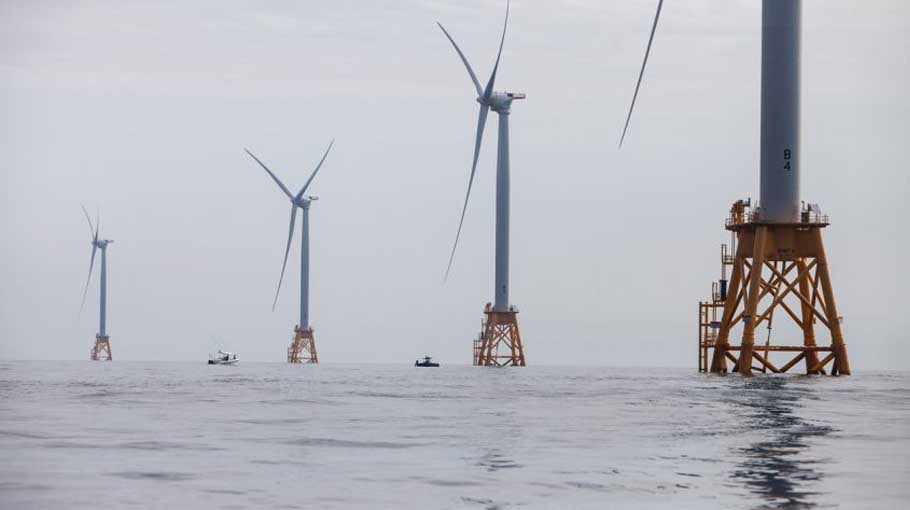Biden admin plans wind farms along US coastline


The Biden administration on Wednesday (Oct 13) announced a plan to develop large-scale wind farms along nearly the entire coastline of the United States, the first long-term strategy from the government to produce electricity from offshore turbines.
Speaking at a wind power industry conference in Boston, Interior Secretary Deb Haaland said that her agency will begin to identify, demarcate and hope to eventually lease federal waters in the Gulf of Mexico, Gulf of Maine, and off the coasts of the mid-Atlantic states, North Carolina and South Carolina, California and Oregon, to wind power developers by 2025.
The announcement came months after the Biden administration approved the nation's first commercial offshore wind farm off the coast of Martha's Vineyard in Massachusetts and began reviewing a dozen other potential offshore wind projects along the East Coast.
On the West Coast, the administration has approved opening up two areas off the shores of central and Northern California for commercial wind power development.
Read more: US to lift travel ban for fully jabbed on Nov 8
Taken together, the actions represent the most forceful push ever by the federal government to promote offshore wind development.
"The Interior Department is laying out an ambitious road map as we advance the administration's plans to confront climate change, create good-paying jobs and accelerate the nation's transition to a cleaner energy future," Ms Haaland said.
"This timetable provides two crucial ingredients for success: increased certainty and transparency. Together, we will meet our clean energy goals while addressing the needs of other ocean users and potentially impacted communities."
President Joe Biden has pledged to cut the nation's fossil fuel emissions 50 per cent from 2005 levels by 2030 by designing policies to promote the use of electric vehicles and clean energy such as wind and solar power.
In particular, the administration has pledged to build 30,000 megawatts of offshore wind in the United States by 2030.
In Congress, Mr Biden is pushing for passage of a major spending Bill that includes a US$150 billion (S$202.42 billion) programme that would pay electric utilities to increase the amount of electricity they purchase from zero-carbon sources such as wind and solar, and penalise those that do not.
Mr Biden has also sought to unite his Cabinet in finding ways to promote renewable energy and cut the carbon dioxide that is warming the planet under what he has called an "all-of-government" approach to tackling climate. Experts in renewable energy policy said that the Interior Department's move represents a major such step.
"This is very big, big deal. This is a signal like we've never had before in the United States about where we can go with offshore wind," said Mr Dan Reicher, who was assistant secretary at the Department of Energy in the Clinton administration and now advises Magellan Wind, which develops projects with offshore floating turbines.
"I've been in the wind industry for a long time," Mr Reicher said. "This is a repeat of what we did a couple of decades ago when we stepped up onshore wind, when it went from being a small niche source of energy to being a mainstream, affordable source of power."
Still, there is no guarantee that companies will lease space in the federal waters and build wind farms. Once the offshore areas are identified, they will be subject to lengthy federal, state and local reviews.
If the potential sites could harm endangered species, conflict with military activity, damage underwater archaeological sites or harm local industries such as tourism, the federal government could deem them unsuitable for leasing.
As they have in response to other offshore wind farms, commercial fishing groups and coastal landowners will likely try to stop the projects.
In the Gulf of Mexico, where oil and gas exploration is a major part of the economy, fossil fuel companies could fight the development of wind energy as a threat to not only their local operations but their entire business model.
"To be making these announcements, and making them in ways that are very political, without looking at what that means, what area, when we still don't know what the effects are going to be of these projects is really problematic," said Ms Anne Hawkins, executive director of the Responsible Offshore Development Alliance, a coalition of fishing groups. "In an ideal world, when you welcome a new industry, you do it in phases, not all at once."
Interior Department officials said they intend to take such considerations into account.
"We are working to facilitate a pipeline of projects that will establish confidence for the offshore wind industry," said Ms Amanda Lefton, director of the Interior Department's Bureau of Ocean Energy Management. "At the same time, we want to reduce potential conflicts as much as we can while meeting the administration's goal to deploy 30 gigawatts of offshore wind by 2030."


